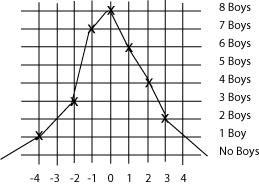
[Approximate Gaussian Distribution curve]
Chapter 5 EXTRA: The boys generate a bell curve
...... Abruptly, Dr. Ralph reached into the shopping
bag and pulled out a small, black, cylindrical container. "Before digital
cameras took over, 35-millimeter film came in these things." He shook it,
and it made a rattling sound. "There's a die in this one. That's one half
of a pair of dice."
...... Dr. Ralph ushered all the kids to line up
on the x=0 coordinate of the floor graph paper, taller kids behind the shorter
ones. He handed each boy a canister from his shopping bag.
...... "Okay," he said when all the boys
were in line, "there is a curve that shows up just about everywhere. The
civilians call it a bell curve, but we scientists call it a Gaussian probability
distribution. It's important that you get a gut feeling for what this curve
means. The curve shows up everywhere in quantum mechanics, and we'll need it
a lot." He shook his canister. "So you guys with your film canisters,
probability canisters, are going to create this curve on the giant graph paper
you're standing on."
...... "Cool!" said Kip.
...... "So here's what we're going to do,"
said Dr. Ralph. "When I say go, shake your probability canisters until
I say stop. Then look inside. If the die shows an even number, move one square
to the left. If it's odd, go one square to the right. And we'll do that over
and over until you guys are pretty spread out. Okay?"
...... "Fun!" said one of the kids.
...... "We could generate the curve in other
ways," said Dr. Ralph, "by measuring the spread in your heights, for
example. But this is more fundamental--and more fun."
...... A few minutes later, accompanied by the
rattling of the probability canisters and boys bumping into each other, the
curve began to take shape: the largest number of boys stood along the x=0 coordinate,
with the number decreasing at increasing distances from x=0.
...... "Okay, guys. Now move forward so that
there are no empty spaces in front of any of you," said Dr. Ralph.
...... The boys moved forward.
...... "Not bad." Dr. Ralph drew a grid
on the blackboard. "Okay," he said. "There are eight kids at
X equals zero." He put an X on the grid at the point 0 and 8 boys. "And
there were six kids at X equals one." He put an X at that point as well.
"And seven at x equals minus one." He Xed in that point, and then
the remaining points. Finally, he drew in lines between the Xs.
...... He stepped back from the board. "This
is a very, very, very crude approximation to the Gaussian curve that you guys
have generated."

[Approximate Gaussian Distribution curve]
...... "To get a good approximation
to the curve," he continued, "we should have a couple of hundred boys
doing this."
...... "Maybe we could get the Amdexter kids
to join in," said Kip.
...... "To generate a Gaussian?" said
Paul. "Yeah, Right!"
...... Dr. Ralph drew a better version of the curve.
"This is how it might look if we used a thousand kids."

[Gaussian Distribution curve]
...... Dr. Ralph turned to the class. "Next
time, we'll use this curve to explore the one-slit experiment."
...... "One slit?" said Wolfgang. "My
dad always talks about the two-slit experiment."
...... "That's the big one," said Dr.
Ralph. "But there are problems even with a single slit." He put down
his chalk. "Interesting problems. And as you consider them, you'll begin
your transformation from civilians to quantum physicists."
...... "Awesome!" said Kip.
Click here to return to Chapter 5.